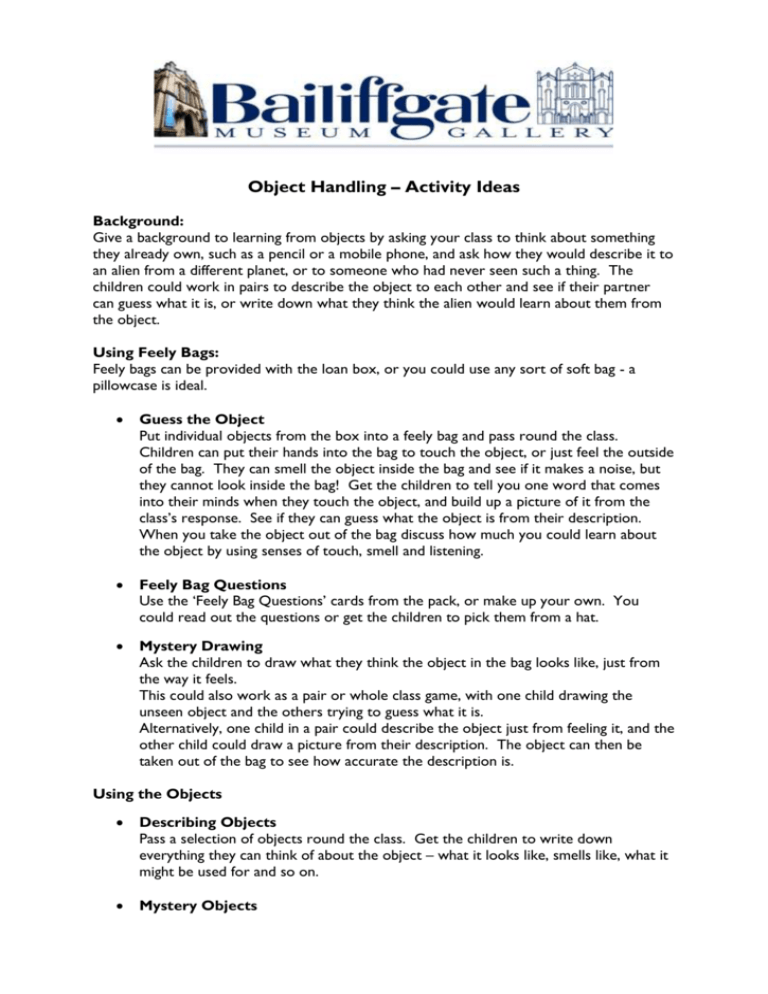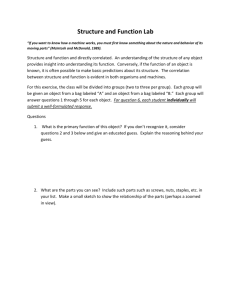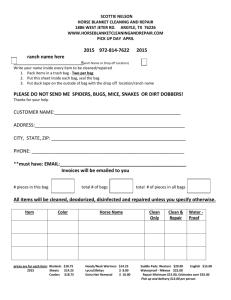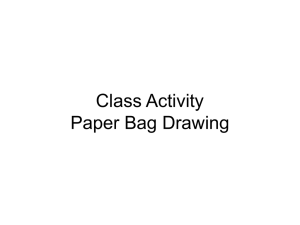a free suggested activity sheet here
advertisement

Object Handling – Activity Ideas Background: Give a background to learning from objects by asking your class to think about something they already own, such as a pencil or a mobile phone, and ask how they would describe it to an alien from a different planet, or to someone who had never seen such a thing. The children could work in pairs to describe the object to each other and see if their partner can guess what it is, or write down what they think the alien would learn about them from the object. Using Feely Bags: Feely bags can be provided with the loan box, or you could use any sort of soft bag - a pillowcase is ideal. Guess the Object Put individual objects from the box into a feely bag and pass round the class. Children can put their hands into the bag to touch the object, or just feel the outside of the bag. They can smell the object inside the bag and see if it makes a noise, but they cannot look inside the bag! Get the children to tell you one word that comes into their minds when they touch the object, and build up a picture of it from the class’s response. See if they can guess what the object is from their description. When you take the object out of the bag discuss how much you could learn about the object by using senses of touch, smell and listening. Feely Bag Questions Use the ‘Feely Bag Questions’ cards from the pack, or make up your own. You could read out the questions or get the children to pick them from a hat. Mystery Drawing Ask the children to draw what they think the object in the bag looks like, just from the way it feels. This could also work as a pair or whole class game, with one child drawing the unseen object and the others trying to guess what it is. Alternatively, one child in a pair could describe the object just from feeling it, and the other child could draw a picture from their description. The object can then be taken out of the bag to see how accurate the description is. Using the Objects Describing Objects Pass a selection of objects round the class. Get the children to write down everything they can think of about the object – what it looks like, smells like, what it might be used for and so on. Mystery Objects Choose one or two unusual objects and pass them round, without telling the children what they are. Ask the children to mime how they think the object should be used or even perform a short play, then see if anyone has guessed the correct use of the object. Mystery Packages Wrap a selection of interestingly shaped objects in tissue or wrapping paper and get small groups of children to see if they can tell what the object is made of and what it is used for without opening the package. They can tell the rest of the class their ideas and then unwrap the objects to see if they were right! Object Questions Either use one item from the box at a time or give one object to each child or small group of children. Use the ‘Object Questions’ cards from the pack, or make up your own. You could either read out selected questions or get each child to pick a card from a hat and answer the question on the card. Three Words With the children in small groups, get them to write down three words to describe an object, without using the name of the object. Another group then has to guess what the object is from the short description. With a small class or lots of objects this would also work well with pairs, with one partner describing and the other guessing. This could be extended into writing short poems or haikus about the objects. What’s the Object? One person (or the rest of the class) is positioned so they cannot see the objects. Another person then describes an object and what it is used for, and the other person or people guess the object. As an alternative, the person describing could act out the use of the object and see if the other people can guess the object from their performance. Ten Questions Pairs of children sit back to back. One of the pair has an object and the other person must try to guess what the object is by asking ten closed questions. The person with the object must only answer either ‘yes’ or ‘no’. Mystery Drawing In pairs, one person describes an object to their partner (from whom the object is hidden), and they try to draw it from the description alone. The rest of the class can then try to spot the object from the drawing. Object Reporting Photocopy the object report sheets in this pack and use them to create a detailed description of an object, involving writing descriptions, weighing and measuring. Memory Game Place the objects on a table and get the children to memorise them. Then cover up the objects and ask the children to write down or draw the objects they can remember. You could also take away one object at a time and see if the children can spot which one is missing. Classification Get the children to group the objects into different categories, for example, what they are made of, what they are used for, who they would have been used by, how they are made. Object Stories We don’t often know the stories behind the objects in the boxes – who used them, where they were bought, how they came to be in the Museum. The class could write a story, song, play or newspaper article about a particular object’s ‘life story’. Advertising Discuss how some of the objects might have made people’s lives easier, helped them to do a job or helped them to have fun. Think about the different ways in which things may be valuable to people – either financially, socially or sentimentally. Ask the children to design an advertisement for a magazine, billboard or television station to sell a chosen object. They could think about who might want to buy or use the object, how using the object would help people, and how much the object should cost. You could look at some advertisements from the past and discuss how different advertisements are today. Compare and Contrast Bring in modern versions of the objects in the box and ask the class to compare old and new. There is a photocopiable ‘Compare and Contrast Objects’ sheet in this pack. Ageing Objects Some of the objects in the box will be showing signs of age, such as rusting and crumbling. This could be used as a starting point for a discussion about preserving objects, and why some objects in museums are kept in special conditions, or about the different materials we use today (such as plastics) and what will happen to them in the future. You could start by wrapping the object and letting the children unwrap it to give them an idea of how precious it might have been. Classroom Museum Use the objects to set up a museum display in your classroom. You could also get the class to bring in objects from home. The children could write descriptions of each item, and decide how the objects are to be displayed and looked after. Drawings and stories about the objects could be added to the display, and you could have a grand launch with class newspaper stories about the new museum, and invite other classes. Children could write a guidebook to the museum for its visitors. Children could make a ‘Museum of Myself’, bringing in items from home that represent them and would tell people the story of their lives, or make a Museum of the Future with objects from today which would describe the way our lives are now for the people of the future. Copyright Bailiffgate Museum 2014






